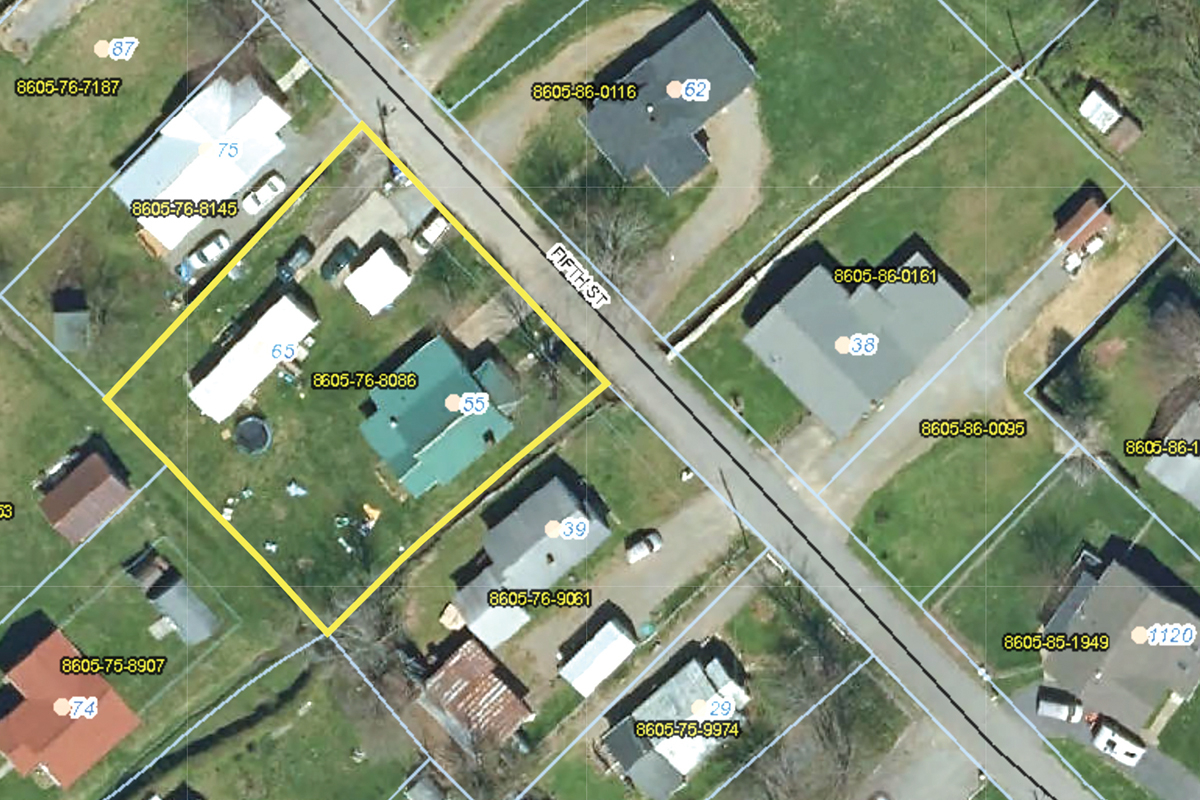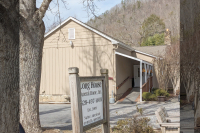‘What ... shortage?’: Waynesville zoning member’s opposition to subdividing lot delays final vote
 Haywood County property records still show the dilapidated trailer and accessory structure that have since been removed from a parcel at 55 Fifth St. in Waynesville. Haywood County photo
Haywood County property records still show the dilapidated trailer and accessory structure that have since been removed from a parcel at 55 Fifth St. in Waynesville. Haywood County photo
A relatively straightforward request to subdivide a single lot and build an affordably priced long-term rental duplex on it was withdrawn by the applicants after opposition from a lone member of Waynesville’s Zoning Board of Adjustment.
“What is the affordable housing shortage?” asked Henry Kidder, vice chair of the ZBA, during a Feb. 6 hearing.
“Have you read the papers lately?” Chair George Escaravage shot back.
The exchange came in the context of a hearing on the request of two developers, Dennis Downey and Gene Sandlin, who are working with SECU*RE Inc., a subsidiary of State Employees' Credit Union that in 2020 bought the foreclosed 0.32-acre parcel on Fifth Street, just off Sulphur Springs Road.
The southeastern half of the parcel is currently occupied by a small single-family home built in 1935. The northwestern half used to host an accessory structure and a mobile home, both of which became dilapidated and were recently torn down and removed.
Developers want to split the lot in two and construct a duplex where the mobile home used to be.
Related Items
A 2021 study by the Dogwood Health Trust estimated a 1,445-unit rental housing deficit in Haywood County at that time.
Unfortunately for the developers, the minimum lot size in the Sulphur Springs Neighborhood Residential zoning district is one sixth of an acre, which works out to a minimum size of 7,230 square feet. Splitting the parcel would create two lots, each approximately 305 square feet below the minimum lot size.
Sulphur Springs is one of Waynesville’s oldest neighborhoods; as such, there are already several legally nonconforming “grandfathered” parcels even smaller than the two that the developers sought to create — three on Fifth Street, and three more on Seventh Street.
Currently, the SS-NR zoning district has one of the highest allowable development densities in town, with up to 10 units per acre or 16 with a special use permit.
The Town of Waynesville’s 2035 Comprehensive Land Use Plan describes the character of the area as “ideal for high quality dense development” because that’s been the character of the area for nearly a century.
Kidder, who was first appointed to the ZBA on June 23, 2015, said he wasn’t familiar with the existence of a comprehensive plan. The plan was adopted by the Board of Aldermen on Sept. 8, 2020 to replace a longstanding predecessor plan.
“Could I ask about this — first I’ve heard of it — what is it, this 200-page ‘future plan 2035?’” he said.
North Carolina’s General Statutes stipulate that as a condition of being allowed to adopt and enforce zoning regulations, local governments must “maintain a comprehensive plan or land-use plan.”
“That’s not a law, that’s a plan, right?” Kidder continued. “So we shouldn’t consider that. We should only consider the [town’s land development standards].”
The standard of review for a variance includes four main categories, the last of which explicitly states that in order to approve a variance, the ZBA must find the proposal “consistent with the spirit, purpose and intent” of the regulation.
The Comprehensive Plan, adopted after more than two years of heavy media coverage, public hearings and input from community members is the document that expresses the spirit, purpose and intent of the regulation.
Throughout the hearing, Kidder asked tough questions of town staff and the applicants, suggesting he might be disinclined to vote for the variance. At one point, he even suggested developers turn it into a park and give it to the town.
Per state law, variances require a four-fifths majority of voting members for approval, but since ZBA member Joshua Morgan was absent without explanation, the developers couldn’t afford to lose a single vote from the four members that were present.
Before polling the board on their opinions, Escaravage offered his own.
“The fact that if they subdivided the lot, they’re making it 0.16 [acres] or within 300 square feet. I mean, it’s minuscule. Does that make a difference? I think it does,” he said. “I mean, I don’t personally have a problem with that.”
Board member George Hermann appeared supportive, but for a different reason.
“Understanding that there was a previous structure occupied on that same property, the subdivision of this [parcel] does not bother me at all,” Hermann said. “In fact, it makes it more practical.”
Judi Donovan, an alternate to the board, concurred with Hermann and noted that as a member of the Historic Preservation Commission, she was familiar with the neighborhood through recent restoration work on the town’s nearby Sulphur Springs Park.
“Knowing that there had already been an existing home there that at some point somebody lived there, there’s two driveways, which clearly denote access. I think it offers an improvement to the area,” Donovan said. “And again, the affordable housing is the number one topic in Haywood County, in all aspects, whether it’s new apartments coming or something like this, that can be beneficial in the neighborhood.”
With a potential 3-1 vote looming — which wouldn’t have been sufficient to grant the variance — Escaravage deferred to the applicants, asking them if they wanted to move forward with the vote.
Ron Sneed, the ZBA’s attorney, advised the applicants that if their variance request was voted down, they wouldn’t be able to apply again for some time. Sneed said he couldn’t remember the exact waiting period, but that it was maybe six months to a year.
“If you’re turned down tonight, can you come back and make this request again before this board? It’s doable,” Sneed said. “But there’s a fairly large time before you’re allowed to do that.”
However, if the applicants were to rescind their application, they could reapply immediately — and hopefully be heard before a full board, where they could afford to lose a single vote and still get their variance.
After a brief conference in the hallway, applicants Downey and Sandlin returned and informed Escaravage of their decision.
“We would like to rescind the application,” Downey announced.
After the meeting, Downey told The Smoky Mountain News that they made the decision due to the absence of the fifth board member.
“It wasn’t a full board, and although we had good vibes all the way through, we felt that it was best to have at least one more member present to make sure that our vote went through,” Downey said.
Downey and Sandlin were hired to split the parcel and develop it by Toby Hartsell, who is the senior vice president of SECU*RE for a region that spans from Burke County to Cherokee County. SECU*RE owns 1,800 homes statewide, all of them long-term rentals. Haywood County property records show SECU*RE owns 15 properties in Haywood County as of January.
Hartzell said on Feb. 10 that they plan to reapply for the variance in short order. It could end up back on the ZBA agenda next month.
“Our mission is to serve the needs of our members and right now we know that adding additional long-term rentals, there’s a great need for that,” he said. “We can make this lot useful right now, as opposed to it not really serving a purpose. Most of that market is fixated on Airbnbs and that’s affecting the housing market.”
Hartzell added that they could put a mobile home right back on the parcel where the previous one was — without going through the ZBA — but that such a structure wouldn’t appreciate in value over time the way a traditional home might and wouldn’t necessarily help with the affordable housing crisis.
Since some homebuyers have no need for two separate dwellings on one lot, splitting the parcel and putting new construction on it would also increase the chances that SECU*RE could one day sell the lot, perhaps to the renter.
“We want to turn renters into homeowners,” Hartsell said.
Correction: the story has been updated to note the State Employees' Credit Union as the parent entity of SECU*RE, not Southeastern Credit Union.













